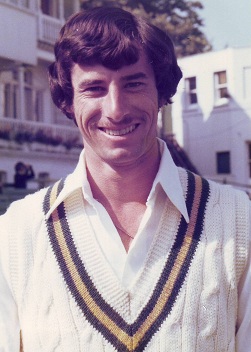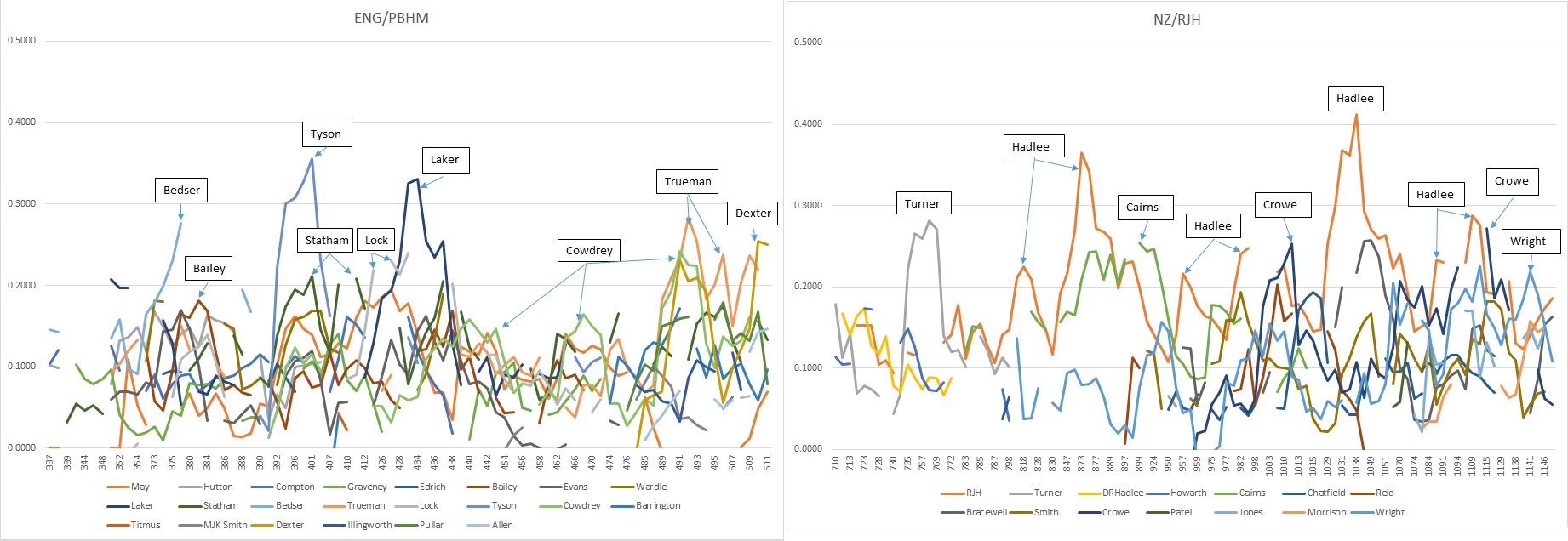Big Fish, Small Pond?
Dave Wilson |
Richard Hadlee is generally considered to have been one of the greatest cricketers of all time, as well as one of the finest fast bowlers ever. Andrew Miller’s cricinfo profile states that ‘Few players in the history of cricket have carried the fortunes of their team to quite the same extent as Richard Hadlee.’ The implication of that statement is that his surrounding cast were nowhere near Hadlee in ability, though of course it’s difficult to say exactly to what extent that is down to Hadlee’s brilliance as opposed to the lesser capabilities of his team mates.
Peter May, meanwhile, is described in his Wisden obituary as the man who ‘came to represent the beau ideal of English batmanship and sportmanship’ and ‘the hero of a generation of schoolboys.’ Richie Benaud contended he was not only the greatest English batsmen since the war, but ‘the only great one.’ However, the same obituary notes that he ‘had the advantage that the best bowlers were nearly always on his side’, and indeed if we compare the list of players who rubbed shoulders with both players, ranked by their ICC rating, the general consensus seems to be supported:-
MAY (941)
945 Hutton
917 Compton
914 Barrington
912 Lock
903 Bedser
898 Trueman
897 Laker
874 Cowdrey
870 Dexter
831 Wardle
810 Statham
HADLEE (909)
845 Turner
804 Howarth
These ratings would tend to suggest that it was actually England’s batting was uppermost during May’s career, though of course Hutton and, to a lesser extent, Compton were both approaching the end of their Test careers as May became established. Nonetheless, we can see the yawning gap in apparent class, with May able to enjoy a full squad’s worth of colleagues rated at 800 or more (short of a wicket-keeper), while Hadlee could call upon only two such luminaries to share the burden with him.
May’s individual rating is 941, just behind Hutton and fifth highest rated batsman of all time, while Hadlee rates at 909, joint eleventh of all time in bowling. It would seem on the surface that May is the greater of the two, though both have been honoured with induction to the ICC Hall of Fame.
As I’ve contended in previous features, the ICC ratings, as well as traditional aggregates and averages, can ony compare players in respect of their main discipline, whereas Match Impact can do so for everything a player does. What I’d like to in this piece is apply Match Impact to see if the above consensus is true in terms of impact, and measure just how much each of these two greats meant to his team. Many earlier features have explained the match impact system, however you can find further explanation here and here.
By taking each player’s current match impact, averaged over five matches, we can then compare that rating as a percentage of his team’s aggregate rating – in this way we get a picture of how much each player represented in terms of his side’s win probability:-

CLICK TO ENLARGE
These graphs show the percentage of both May and Hadlee in terms of their moving match impact average as a percentage of the aggregate of moving match impact average of the individuals who made of each side, throughout the careers of the two players. It would certainly seem from this that Hadlee represented much more of the impact of the teams on which he played than did May, indeed up to twice as much.
Of course the above is based on percentages, and if, as we earlier contended, May’s sides were higher quality then it could be that their actual impact was more comparable. Below we have graphs which plot the aggregate individual impact for May’s England sides and Hadlee’s New Zealand sides, in each case showing the ratings with and without each player’s contribution:-

CLICK TO ENLARGE
This cofirms that Hadlee did in fact have a higher actual impact than did May; the line at 0.9 represents an average side’s aggregate match impact, and we can see that Hadlee’s impact was enough to lift his side to be above average. While May did not have as much actual impact as Hadlee, it’s important to note that he had most impact when it was needed, i.e. when England’s side was not as strong as previously. We can see such a dip between Tests 409-427, when it was May’s contribution which elavated his team. In the first sewries of that period, against South Africa in 1955, May was incredible in second innings play he avraged 138 over four Tests, making high scores at crucial times in true captain’s fashion. That great form continued into the 1956 Ashes, when he averaged over 90 as England retained the Ashes. A dip in form in SOuth Africa was blamed on facing Heine and Adcock, though May had handled those two in 1955, and is possibly down to being his first overseas tour as captain. Back in England in 1957 May enjoyed possibly his finest hour, his 285* saving a mtahc which looked lost and which, perhaps not surprisingly, is his highest rated impact match.
Hadlee had a flare for the dramatic – his first 10-for saw New Zealand to her first ever victory over England, and he closed his career with a wicket from his last ball in Test cricket. IN between were many high impact performances, including a dominating 15-wicket haul against Australia. HIs 11 wickets and a swashbuckling 51 in 63 balls powered New Zealand to a one-wicket victory over the West Indies in 1980, while his ten-for against Australia at the MCG in 1987 just failed to bring victory in a thrilling draw.
Of course, it’s one thing to have great players alongside you but they need to be firing on all cylinders too if victory is to be achieved. The graphs below show the match impact averages of all of the major members of both sides during May and Hadlee’s careers:-

CLICK TO ENLARGE
What we can see glaringly here is how much May’s sides relied on their bowling – all of the most impactful players between 1951 and 1957 were bowlers or, in the case of Bailey, a bowling all-rounder. We can also see that, although Hadlee stands alone in terms of peak impact rating, he wasn’t alone as far as showing the way – Glenn Turner, Lance Cairns and Martin Crowe were all leading lights at one time or another during Hadlee’s career.
Which leads us nicely onto team impact. We would expect that May’s England would rate higher than Hadlee’s New Zealand, and indeed looking back at the graph showing the team ratings with and without each player England does have a higher peak than New Zealand. However, when we look at average rating, England rates at around 0.95, though excluding Australia’s strong 1958-59 side it would be as low as 0.91. New Zealand on the other hand, averages out at 1.07 over Hadlee’s career. How can that be? England were much more successful in the 1950s than New Zealand were during Hadlee’s time – England won 33, drew 18 and lost 15 during May’s time, while Hadlee’s New Zealand won 22, drew 36 and lost 28 – England were much more successful.
The answer is in strength of opposition. Some time ago I put together a list of historic ratings based on the current ICC Test team rating system, going back to 1877. If we look at England’s opponents during May’s time, the average ICC rating is 83; meanwhile Hadlee’s New Zealand faced opponents who averaged 100, much stronger than May’s opponents rated.
This also explains why May’s side were able to maintain a winning record when the team was weaker impact-wise, as it was during the Tests played between 1958 and 1960 when their average impact was just 0.62 – this was because their average opponent averaged around the same.
In summary, what have we seen?
a) May’s team wasn’t as good as I originally thought
b) Hadlee’s team wasn’t as bad as I originally thought
c) Hadlee in his prime was worth twice as much to his team as May was to his
d) Hadlee’s New Zealand may well have been as successful as May’s England given lower quality opposition
e) May was a captain in every sense of the word
Though I would expect agreement only on the last point, I will say that Hadlee was indeed a very big fish – though his pond was possibly not as small as previously thought.





Leave a comment